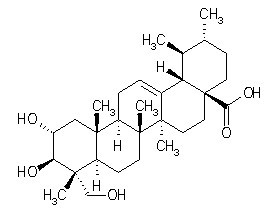| Synonyms | (1S,2R,4aS,6aR,6aS,6bR,8aR,9R,10R,11R,12aR,14bS)-10,11-dihydroxy-9-(hydroxymethyl)-1,2,6a,6b,9,12a-hexamethyl-2,3,4,5,6,6a,7,8,8a,10,11,12,13,14b-tetradecahydro-1H-picene-4a-carboxylic acid |
| Applications | Asiatic acid markedly inhibited cancer cell proliferation. Apoptosis of SW480 human colon cancer cells was induced by asiatic acid as shown by flow cytometry, DNA fragmentation and nuclear chromatin condensation experiments. Through increasing mitochondrial membrane permeability and cytochrome c release from mitochondria into cytosol, asiatic acid induced caspase-9 activity, which further activated caspase-3 and poly(ADP-ribose) polymerase cleavage resulting in irreversible apoptotic death in the tumor cells. Taken together, these results suggest that mitochondrial death apoptosis cascade plays very important roles in asiatic acid-induced cancer apoptosis.
The anticancer effect of asiatic acid in two human breast cancer cell lines, MCF-7 and MDA-MB-231. Asiatic acid exhibited effective cell growth inhibition by inducing cancer cells to undergo S-G2/M phase arrest and apoptosis. Blockade of cell cycle was associated with increased p21/WAF1 levels and reduced amounts of cyclinB1, cyclinA, Cdc2, and Cdc25C in a p53-independent manner. Asiatic acid also reduced Cdc2 function by increasing the association of p21/WAF1/Cdc2 complex and the level of inactivated phospho-Cdc2 and phospho-Cdc25C. Asiatic acid treatment triggered the mitochondrial apoptotic pathway indicated by changing Bax/Bcl-2 ratios, cytochrome c release, and caspase-9 activation, but it did not act on Fas/Fas ligand pathways and the activation of caspase-8. We also found that mitogen-activated protein kinases (MAPKs), extracellular signal-regulated kinase (ERK1/2), and p38, but not c-Jun NH2-terminal kinase (JNK), are critical mediators in asiatic acid-induced cell growth inhibition. U0126 [1,4-diamino-2,3- dicyano-1,4-bis(2-aminophenylthio)butadiene] or SB203580 [4-(4-fluorophenyl)-2- (4-methylsulfinylphenyl)-5-(4-pyridyl)-1H-imidazole], specific inhibitors of mitogen- activated protein kinase kinase and p38 kinase activities, significantly decreased or delayed apoptosis. Asiatic acid was likely to confine the breast cancer cells in the S-G2/M phase mainly through the p38 pathway, because both SB203580 and p38 small interfering RNA (siRNA) inhibition significantly attenuated the accumulation of inactive phospho-Cdc2 and phospho-Cdc25C proteins and the cell numbers of S-G2/M phase. Moreover, U0126 and ERK siRNA inhibition completely suppressed asiatic acid-induced Bcl-2 phosphorylation and Bax up-regulation, and caspase-9 activation. Together, these results imply a critical role for ERK1/2 and p38 but not JNK, p53, and Fas/Fas ligand in asiatic acid-induced S-G2/M arrest and apoptosis of human breast cancer cells.
Asiatic acid (5–20 µM) inhibits HUVEC growth and induces apoptotic cell death by activating caspases (3 and 9) and modulating the expression of apoptosis regulators Bad, survivin and pAkt-ser473. Further, Asiatic acid showed a dose-dependent inhibition of HUVEC migration, invasion and capillary tube formation, and disintegrated preformed capillary network. Asiatic acid also inhibited the VEGF-stimulated growth and capillary tube formation by HUVEC and HBMEC. Next, we analyzed the angiogenic potential of conditioned media collected from human glioma LN18 and U87-MG cells treated with either DMSO (control conditioned media, CCM) or AsA 20 µM (Asiatic acid 20 conditioned media, Asiatic acid 20CM). CCM from glioma cells significantly enhanced the capillary tube formation in both HUVEC and HBMEC, while capillary tube formation in both endothelial cell lines was greatly compromised in the presence of Asiatic acid 20CM. Consistent with these results, VEGF expression was lesser in Asiatic acid 20CM compared to CCM, and indeed Asiatic acid strongly inhibited VEGF level (both cellular and secreted) in glioma cells. Asiatic acid also showed dose-dependent anti-angiogenic efficacy in Matrigel plug assay, and inhibited the glioma cells potential to attract HUVEC/HBMEC. Overall, the present study clearly showed the strong anti-angiogenic potential of Asiatic acid and suggests its usefulness against malignant gliomas.
|


